
n 2017, the street photographer Jeff Mermelstein took a shot in midtown Manhattan. “I saw a woman sitting outside a cafe on her phone; I was just curious and I made a picture of her screen, of her hand on it.”
After Mermelstein had captured the image on his iPhone – which he now favours over Leicas and Canon SLRs – he zoomed in on her phone screen. She had been searching for information about wills. “I remember a line about her father having left $6,000 in in attic,” he says. “It was this little short story. That brought my attention into a new territory.”
New territory perhaps because the photographer is no digital native. Mermelstein was born in Brunswick, New Jersey, in 1957, and studied under the great NYC photographer Garry Winogrand. The kind of imagery he has made for much of his working life has more in common with the classic, 35mm sidewalk reportage of Diane Arbus or Joel Meyerowitz, than it has with the lines we all write in text messages.
Nevertheless, he sensed he was on to something. “Shortly afterwards I was near a Whole Foods, and I saw someone else on her phone,” he recalls. “I took a picture and it was an intriguing and flat-out funny exchange about her having an extra piece of fish. She wanted to give it to the other person, but they had already eaten swordfish, but she was going to take it anyway. And then it really started to percolate.”
The results of that three-year percolation have just been published. Entitled #nyc after the hashtag Mermelstein added to many of the images when posting them on Instagram, this 160-page photobook is a bumpy ride through contemporary New York society.
There are botched drug deals, break-ups, hook-ups, cancer scares, at least one unwanted pregnancy, a quote from Marcus Aurelius, and an offer of a cantaloupe melon as a “consolation prize”. “That one befuddles me,” Mermelstein says. “Maybe it was secret code communication, but it is so spontaneous, and its real, it’s fascinating.”
He says he could never accurately judge which passerby might be sending a noteworthy message via their handset. “Some of the most bombastic ones, the ones where I had to sit down, were from a person that looked ‘normal’,” says the photographer.
In pretty much every case, he did not ask permission to shoot a subject’s screen, and he’s taken care to ensure any identifying information is obscured. None of the images were shot on the subway: “I need more air to breathe as a picture maker,” he says.
He’s coy when it comes to explaining his precise technique, though he does reveal that these images were among the most challenging he has ever taken. Even his wife, who helped edit this book, can’t work out how he photographed some of them. In any case, Mermelstein says it is “extraordinarily difficult to make a street photograph that’s memorable”.
Why? “I think a transition point might have occurred with the death of Lady Di,” he says. Many blamed the paparazzi for the car crash that killed Diana, Princess of Wales. “After that, 9/11 happened, and then there was heightened awareness and worry about security and imagery in public. Those two ingredients contribute to the challenge.”
While New Yorkers might be more guarded around street photographers, Mermelstein’s ability to peer at their phone screens has enabled him to reveal a side to the city – such as the drug and sex trades – that’s no longer on public view. “Back in the 80s you saw more street-corner drug dealing,” he says. “So it makes sense that stuff is all done with a text.”
And the sex? “There’s a lot of sex on the street in texting, but I wasn’t looking for that specifically. Ordinarily, I didn’t read the texts before I took them.” Mermelstein prefers “the absurdist, bizarre, nonsensical communications”. “They tickle me harder somehow,” he says.
As if to avoid any fine-art qualities in his images, Mermelstein has added a blue wash to the pages of #nyc. “In a way it’s quite radical, isn’t it?” he says. “It makes the photographs less about photography. Maybe it’s more fun to think about it as literature and how literature and photographic images can work.”
As a literary work, #nyc can be a little bleak. Though many of the entries read like something you mind find on the website Overheard in New York, the cumulative impression is of a city filled with strange needs, that’s wild at heart and weird on top.
Mermelstein says his own phone wouldn’t offer up much of interest to a snooping photographer. “My last text is probably something to my wife; not graphic sexual, but I guess corny affectionate.”
His book, he says, “reflects a multitude of layers and ingredients of a pretty wild place, and also a pretty mad time. It’s filled with concern, joy, pathos and love and craziness.” Not a bad set of characteristics for the Big Apple; and perhaps that’s the real message we should get from #nyc: that New York, despite years of quality-of-life policing and moneyed gentrification, has, via its handsets, retained its untamed side.












